
Bamboos are a diverse group of evergreen perennial flowering plants making up the subfamily Bambusoideae of the grass family Poaceae. Giant bamboos are the largest members of the grass family. The origin of the word "bamboo" is uncertain, but it probably comes from the Dutch or Portuguese language, which originally borrowed it from Malay or Kannada.

The Restionaceae, also called restiads and restios, are a family of flowering plants native to the Southern Hemisphere; they vary from a few centimeters to 3 meters in height. Following the APG IV (2016): the family now includes the former families Anarthriaceae, Centrolepidaceae and Lyginiaceae, and as such includes 51 genera with 572 known species. Based on evidence from fossil pollens, the Restionaceae likely originated more than 65 million years ago during the Late Cretaceous period, when the southern continents were still part of Gondwana.

Arundinaria, commonly known as canes, is a genus of bamboo in the grass family.
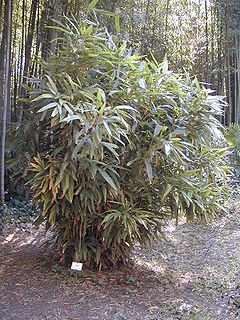
Indocalamus is a genus of about 35 species of flowering plants in the grass family (Poaceae), native to China, Vietnam and Japan. They are quite small evergreen bamboos normally up to 2 m (6.6 ft) in height, initially forming clumps and then spreading to form larger thickets. They have thick, glossy leaves. Ruo leaves use to wrap foods like rice during dragon boat festival, originate in fujian refer to Indocalamus longiauritusoriginally but now are nonspecific to just about any leaf wrap.

Thamnocalamus is a genus of clumping bamboo in the grass family. These species are found from the Himalayas as well as Madagascar and Southern Africa.

Joseph Marie Henry Alfred Perrier de la Bâthie was a French botanist who specialized in the plants of Madagascar.
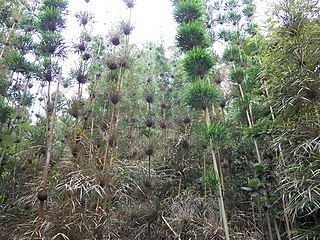
Nastus is a genus of slender, erect, scrambling or climbing bamboos in the grass family. It is native to Southeast Asia, Papuasia, and certain islands in the Indian Ocean.
Arundinaria appalachiana, commonly known as hill cane, is a woody bamboo native to the Appalachian Mountains in the southeastern United States. The plant was elevated to the species level in 2006 based on new morphological and genetic information and was previously treated as a variety of Arundinaria tecta. As a relatively small member of its genus, it usually only attains heights of 0.5 to 1.0 metre with an either dense or diffuse habit. It is one of only three temperate species of bamboo native to North America. Hill cane is common on dry to mesic sites on upland slopes, bluffs and ridges in oak-hickory forests. In contrast to its sympatric relatives, Arundinaria gigantea typically appears along perennial streams, while A. tecta is found in swamps and other very wet areas.

Protea aristata is a compact shrub with beautiful flowers which is endemic to the southwestern part of the Cape Region of South Africa. P. aristata has become one of South Africa's most famous proteas in spite of its relatively late discovery, and re-discovery in 1953. The leaves are soft, dense and needle-like and the flower heads are a stunning crimson red, it may thus be a good potential ornamental plant for South African gardens. It is usually called the Ladismith sugarbush in South African English, although it has been called pine sugar bush in Australia. In the Afrikaans language it has the vernacular name of klein-den-suikerbos.
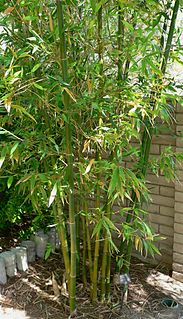
Bambusa oldhamii, known as giant timber bamboo or Oldham's bamboo, is a large species of bamboo. It is the most common and widely grown bamboo in the United States and has been introduced into cultivation around the world. It is densely foliated, growing up to 20 metres tall in good conditions, and can have a diameter of up to 10 centimetres.

The Bambouseraie de Prafrance is a private botanical garden specializing in bamboos, located in Générargues, near Anduze, Gard, Languedoc-Roussillon, France. It is open daily in the warmer months; an admission fee is charged.

Oxytenanthera is a genus of African bamboo. Bamboos are members of the grass family Poaceae.

Arundinaria gigantea is a species of bamboo known as giant cane and river cane. It is endemic to the south-central and southeastern United States as far west as Oklahoma and Texas and as far north as New York. This species is divided into two subspecies. The subspecies tecta is sometimes treated as a species in its own right, Arundinaria tecta, and is the taxon generally called switch cane. It is very similar to the nominate subspecies (gigantea), but is often smaller and tends to grow in wetter habitats.

Fargesia murielae, the umbrella bamboo, is a species of flowering plant in the family Poaceae. It is a large, clump-forming evergreen bamboo, closely resembling Fargesia nitida in the same genus, but with yellow canes.

Indocalamus tessellatus, the large-leaved bamboo, is a species of flowering plant in the grass family Poaceae, native to China. A medium-sized, hardy evergreen bamboo growing to 2 m (6.6 ft), it forms a clump of broad leaves 60 cm (24 in) long and up to 10 cm (3.9 in) wide – the broadest of any bamboo – which cause the slender cane to bend under their weight. Though hardy down to −15 °C (5 °F) and able to survive conditions in most of the UK, it prefers a sheltered site in semi-shade with moist, rich soil. Given the best conditions possible, it will eventually form large thickets or groves, but can be kept in a large container. In cultivation in the UK it has gained the Royal Horticultural Society's Award of Garden Merit.

Protea effusa, sometimes known as the scarlet sugarbush, is a flowering plant which belongs to the genus Protea. The plant is endemic to the Western Cape province of South Africa. In the Afrikaans language the vernacular name blosrooisuikerbos has been recorded for this plant.

Protea foliosa, also known as the leafy sugarbush, is a flowering plant of the genus Protea in the family Proteaceae which is endemic to the Cape Region of South Africa. In the Afrikaans language it is known as ruie-suikerbos.

Protea intonsa, also known as the tufted sugarbush, is a flowering plant of the genus Protea within the family Proteaceae, endemic to South Africa, where it is distributed from the eastern Swartberg and Kammanassie Mountains to the Baviaanskloof mountains. In Afrikaans it is known as klossie-suikerbos.
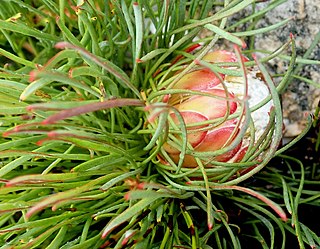
Protea montana also known as the Swartberg sugarbush, is a flowering plant of the genus Protea within the family Proteaceae, which is endemic to the southwestern Cape Region of South Africa. In Afrikaans it is known as swartbergsuikerbos.
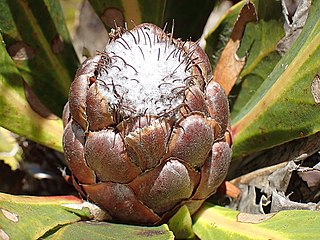
Protea vogtsiae, also known as the Kouga sugarbush, is a small flowering shrub of the genus Protea within the family Proteaceae, which is only found growing in the wild in the southern Cape Region of South Africa.



















